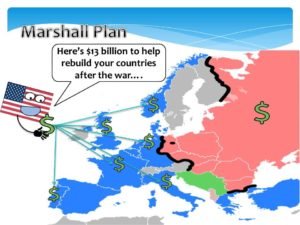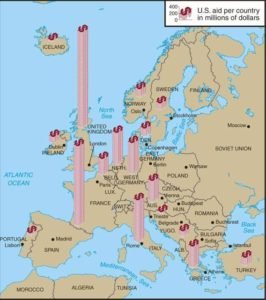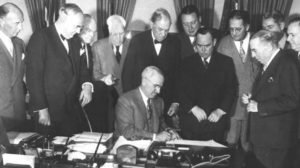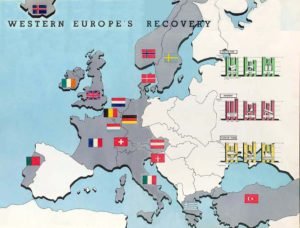Historical Essay:“The Refusal of the Soviet Union to the Marshall Plan of US and Its Consequences”
Introduction

Source
In 1945, the United States and Soviet Union were allies, jointly triumphant in World War II, which ended with total victory for Soviet and American forces over Adolf Hitler's Nazi empire in Europe. But within just a few years wartime allies became mortal enemies, locked in a global struggle; military, political, economic, ideological -to prevail in a new "Cold War.". Later on, several issues arose during the war that threatened the alliance. These included the Soviet refusal to aid the Polish Home Army during the Warsaw uprising of August 1944 and the decision of British and United States officials to exclude the Soviets from the secret negotiations with the German officers in March of 1945 in an effort to secure the surrender of German troops in Italy. These tensions grow into Cold War between United States and Soviet Union because of these underlying reasons; first is Ideological, the United States and the Soviet Union represented two opposing systems of government. In the United States, the government was elected by free elections unlike the Soviet Union. The people could form political parties to voice their political opinions. Second is Economic. The United States wanted to encourage free trade throughout the world. The Soviet Union wanted to shield off her own sphere from international commerce. These differences led to much ill feeling between the United States and the Soviet Union. Third is Power rivalry. After the Second World War, with the decline of Europe, power was largely shared between the Soviet Union and the United States. As one wanted to dominate the other, conflicts were inevitable. Stalin took advantaged and very eager in dominating the western part of Europe. The United States became alarmed with the growing of communism in Europe and set up the Marshall Plan in order to counteract the spread of communism. Because of the attitude of United States during the past wars and towards Europe in spreading Capitalist government it leads to the intensifying conflict between two nations that also lead to the refusal of the Soviet Union to the Marshall Plan proposed by the United States to aid European countries.

Source
Body
George Catlett Marshall was a soldier and a statesman, and a graduate of Virginia Military Academy. He accepted a commission as a U.S Army Lieutenant in 1902. He served in the Philippines and later helped plan the U.S major battles during World War I (1914-1918). He rose steadily through military ranks and commanded junior officers, including Omar Bradley, Dwight Eisenhower and George Patton, who would later serve as renowned generals during World War II. He was appointed by President Franklin Roosevelt as the Army’s chief of staff on September 1, 1939 the day that Germany invaded Poland. He transformed an army that were poorly trained and poorly equipped soldiers into the world’s best equipped military, numbering 8.3 million soldiers. After the war President Harry Trauman appointed him as a Secretary of State. And in June 1948, Marshall suggested a plan that would eventually help save Europe from postwar economic collapse. This program was known as “Marshall Plan” which he earned Nobel Peace Prize.
On the night of June 5, 1947 people were surprised to the speech of the United States Secretary Sir George C. Marshall in Harvard University announcing about the program of reconstructing the devastated Europe to be financed by United States. This program aims to aid European countries to re- stabilized their economy. United States response towards Marshall’s speech was very sluggish. After that day of speech, President Trauman also remarks about the recent events in Hungary, which was consider as the leading story in major American Newspaper. Communist had seized control of that country’s government, while their Prime Minister Ferenc Nagy was out of the country. In other article that provided an account also of the initial response to Marshall’s speech- in Paris. It was stated by reporter Harold Callendar that France is Stirred by Marshall Plan; also he was the first person to use the phrase “Marshall Plan”. However, most of the American newspaper ignored Marshall’s speech. Because the speech contained a few details that it seemed like another impractical idea to be added to the long list of proposed government programs that would never be put into actions.
George C. Marshall first discussed the proposed European Recovery Plan at a news conference a week after his speech. He first sends Undersecretary Will Clayton to Europe to meet European leaders. Marshall emphasized to the reporters that Clayton would not be representing the U.S plan to Europe but instead he would be there to listen to those leaders which would they’ll be the ones to form a plan to help their nations rebuild. Many Americans doubted that the Europeans would cooperate with one another to create this program. At that time, Marshall’s proposal was out of step with popular opinion in the United States. Because during World War II the nation had spent a huge amount of money, resources and many soldiers were killed. The war effort had required Americans to make a lot of sacrifices, every ones daily life had been affected, and they don’t want to return to this kind of misery again.
Since then, after the speech of U.S secretary Sir George C. Marshall, Soviet Union remained silent to it. But as a response to the speech, Nikolai Novikov a Soviet Union’s ambassador sent his initial assessment of Marshall’s speech to Soviet officials in Moscow. In his letter, he said that “the European aid program envisioned by Marshall has two goals. First, it would try to prevent the economies of Western Europe from collapsing. Second and more vital to Soviet interests, he emphasized and believed that the program would serve as a way for the United States to mold Western Europe into a unified federation of actions”. Soviet officials interpreted that the Americans could use this alliance to frustrate soviet policy goals and see it as a plot to control Western Europe and threaten the Soviet Union’s security. And for the other Soviets view, they describe Marshall’s proposal as a plan for political pressure with dollars and a program for interference in the internal affairs of other states. On June 27 in the same year of 1947 Foreign Minister Molotov agreed to a meeting with his British and French counterparts to discuss the European reaction to the American offer. Molotov immediately clears the Soviet objections to the Marshall Plan. First, it would include economic assistance to Germany, and the Russians could not tolerate such aid to the enemy had so recently devastated the Soviet Union. Second, Molotov was adamant in demanding that the Soviet Union have complete control and freedom of action over any Marshall Plan funds Germany might receive. The Foreign Minister wanted to know precisely how much money the United States would give to each nation. When it became clear that the French and British representatives did not share his objections, Molotov stormed out of the meeting on July 2. The Soviet Union pressured its Eastern European allies to reject all Marshall Plan assistance. The pressure was successful and none of the Soviet satellites participated in Marshall Plan. Soviet press claimed in the domestic affairs of other countries. While the United States ignored Soviet action and in 1948, officially established the Marshall Plan and began providing funds to other European nations.
Marshall Plan, formally European Recovery Program, a U.S. sponsored program designed to rehabilitate the economies of 17 western and southern European countries in order to create stable conditions in which democratic institutions could survive. These were the countries of Austria, Belgium, Denmark, France, Greece, Iceland, Ireland, Italy, Luxembourg, the Netherlands, Norway, Portugal, Sweden, Switzerland, Turkey, the United Kingdom, and western Germany. Economic Cooperation Administration (ECA) under by Paul G. Hoffman distributed over the next four years some $13 billion worth of economic aid, helping to restore industrial and agricultural production, establish financial stability, and expand trade. Direct grants accounted for the vast majority of the aid, with the remainder in the form of loans. Marshall Plan was very successful in aiding the European countries. The economic transformation in Marshall Plan countries was striking. The overall industrial production increased 64 percent compare to the prewar percentage.
Conclusion
The attitude that showed by Foreign Minister Molotov during the meeting was an action indicated that the Cold War between United States and Russia were intensifying. For the United States officials, they argued that the Soviet stance was another indication that Russia intended to isolate Eastern Europe from the West and enforce its communist and totalitarian doctrines in that region. They never really wanted the Soviet Union and its satellites to benefit from Marshall Plan aid. They made no further effort to persuade them to take part. While for the Soviet perspective, its refusal to participate in the Marshall Plan indicated its desire to remain free from American economic imperialism and domination. Instead, they created their system in which in lined to the Soviet Union’s perspective, they called it Molotov Plan. Foreign Minister Molotov, organized this Plan which it aims to provide aid to rebuild the countries in Eastern Europe that were politically and economically aligned to Soviet Union, it can be seen to be the USSR’s version of the Marshall Plan. This plan was very symbolic to the of the Soviet Union’s refusal to accept aid from the Marshall Plan or allow any of their satellites states to do so, because of their belief that the Plan was an attempt to weaken Soviet interest in their satellite states through the conditions imposed and by making beneficiary countries economically independent on the United states.
Thank you for reading!
Bibliography
Hogan, Michael J. The Marshall Plan: America, Britain and the Reconstruction of Western Europe, 1947-1952. New York: Cambridge University Press, 1987.
Prentzas, G.S. Milestone in Modern World History: The Marshall Plan. New York: Chealsea House, 2011.
Price, Harry Bayard. The Marshall Plan and Its Meaning. London: Oxford University Press, 1955.
Brien, Sam O'. "Questioning the Marshall Plan in the Build up to the Cold War." Undergraduate Research Journal, 2014.
Unknown Author. “Marshall Plan” accessed February 10, 2018, http://www.history.com/topics/world-war-ii/marshall-plan
Unknown Author. “Soviet Union Rejects Marshall Plan Assistance”, July 2, 1947. Accessed March 8, 2018, https://www.history.com/this-day-in-history/soviet-union-rejects-marshall-paln-assistance
Posted from my blog with SteemPress : http://zam398.vornix.blog/2018/07/31/historical-essaythe-refusal-of-the-soviet-union-to-the-marshall-plan-of-us-and-its-consequences/

